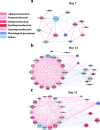Shifting the microbiome of a coral holobiont and improving host physiology by inoculation with a potentially beneficial bacterial consortium
- PMID: 33910503
- PMCID: PMC8082877
- DOI: 10.1186/s12866-021-02167-5
Shifting the microbiome of a coral holobiont and improving host physiology by inoculation with a potentially beneficial bacterial consortium
Erratum in
-
Correction to: Shifting the microbiome of a coral holobiont and improving host physiology by inoculation with a potentially beneficial bacterial consortium.BMC Microbiol. 2021 May 19;21(1):150. doi: 10.1186/s12866-021-02219-w. BMC Microbiol. 2021. PMID: 34011286 Free PMC article. No abstract available.
Abstract
Background: The coral microbiome plays a key role in host health by being involved in energy metabolism, nutrient cycling, and immune system formation. Inoculating coral with beneficial bacterial consortia may enhance the ability of this host to cope with complex and changing marine environments. In this study, the coral Pocillopora damicornis was inoculated with a beneficial microorganisms for corals (BMC) consortium to investigate how the coral host and its associated microbial community would respond.
Results: High-throughput 16S rRNA gene sequencing revealed no significant differences in bacterial community α-diversity. However, the bacterial community structure differed significantly between the BMC and placebo groups at the end of the experiment. Addition of the BMC consortium significantly increased the relative abundance of potentially beneficial bacteria, including the genera Mameliella and Endozoicomonas. Energy reserves and calcification rates of the coral host were also improved by the addition of the BMC consortium. Co-occurrence network analysis indicated that inoculation of coral with the exogenous BMC consortium improved the physiological status of the host by shifting the coral-associated microbial community structure.
Conclusions: Manipulating the coral-associated microbial community may enhance the physiology of coral in normal aquarium conditions (no stress applied), which may hypothetically contribute to resilience and resistance in this host.
Keywords: Beneficial bacterial consortium; Endozoicomonas; High-throughput sequencing; Pocillopora damicornis.
Conflict of interest statement
The authors declare that they have no competing interests.
Figures





References
-
- Costanza R, De Groot R, Sutton P, Van der Ploeg S, Anderson SJ, Kubiszewski I, et al. Changes in the global value of ecosystem services. Global Environ Change. 2014;26:7–158. doi: 10.1016/j.gloenvcha.2014.04.002. - DOI
-
- Woodhead AJ, Hicks CC, Norström AV, Williams GJ, Graham NAJ. Coral reef ecosystem services in the Anthropocene. Funct Ecol. 2019;33(6); doi: 10.1111/1365-2435.13331.
Publication types
MeSH terms
Substances
LinkOut - more resources
Full Text Sources
Other Literature Sources

